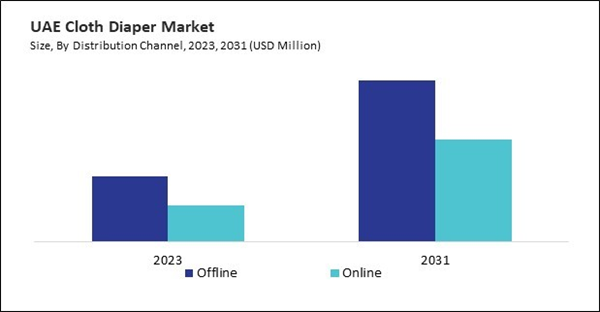The online distribution channel in the cloth diaper market serves as a pivotal platform connecting manufacturers, retailers, and consumers in a seamless and efficient manner. Through e-commerce platforms, specialty websites, and online marketplaces, consumers can explore a wide range of cloth diaper brands, styles, and accessories from the comfort of their homes. This digital channel offers convenience, accessibility, and a diverse selection, allowing customers to compare products, read reviews, and make informed purchasing decisions. Hence, it is expected that 722.9 thousand units of cloth diapers would be sold online by the year 2031.
The Brazil market dominated the LAMEA Cloth Diaper Market, By Country in 2023, and would continue to be a dominant market till 2031; thereby, achieving a market value of $112.7 Million by 2031. The Argentina market is capturing a CAGR of 14.1% during (2024 - 2031). Additionally, The UAE market would register a CAGR of 12.8% during (2024 - 2031).
Several trends shape the cloth diaper market, reflecting evolving consumer preferences, technological advancements, and industry innovations. Modern cloth diapers featuring innovative designs, adjustable sizing, and convenient features such as snap or hook-and-loop closures are gaining popularity among parents. Compared to traditional cloth diapering methods, these diapers offer increased convenience, ease of use, and customizable options.
Moreover, natural fibers such as cotton, bamboo, and hemp are becoming increasingly popular for cloth diaper materials. These fibers are known for their softness, breathability, and absorbency, making them ideal for a baby’s sensitive skin. Parents are seeking diapers made from natural materials as they prioritize comfort and sustainability.
As online shopping platforms become more prevalent and efficient, cloth diapers become easily available to a wider demographic of parents in urban and rural areas. UAE is the leader in e-commerce in the Gulf Cooperation Council (GCC), according to the International Trade Administration (ITA). In 2020, the sector experienced a 53% increase, reaching a record $3.9 billion in e-commerce sales, or 10% of overall retail sales. By 2025, e-commerce will bring in $8 billion in revenue. The growth of e-commerce stimulates market growth for cloth diapers in the UAE. With more online retailers offering cloth diapers, the market expands to meet the increasing demand from environmentally conscious parents seeking sustainable diapering solutions for their children. In conclusion, the growing retail sales and rising e-commerce sector in the region propel the market’s growth.
Based on End-user, the market is segmented into Babies and Adults. Based on Distribution Channel, the market is segmented into Offline and Online. Based on countries, the market is segmented into Brazil, Argentina, UAE, Saudi Arabia, South Africa, Nigeria, and Rest of LAMEA.
List of Key Companies Profiled
- The Procter and Gamble Company
- Nicki’s Diapers, LLC
- Johnson & Johnson
- Bumpadum Manufacturing and Traders Private Limited
- bumGenius (Cotton Babies, Inc.)
- GroVia
- Kanga Care LLC
- Gerber Childrenswear LLC
- SuperBottoms (Navashya Consumer Products Pvt Ltd)
- Bumkins Finer Baby Products, Inc
Market Report Segmentation
By End-user (Volume, Thousand Units, USD Billion, 2020-2031)- Babies
- Adults
- Offline
- Online
- Brazil
- Argentina
- UAE
- Saudi Arabia
- South Africa
- Nigeria
- Rest of LAMEA
Table of Contents
Companies Mentioned
- The Procter and Gamble Company
- Nicki’s Diapers, LLC
- Johnson & Johnson
- Bumpadum Manufacturing and Traders Private Limited
- bumGenius (Cotton Babies, Inc.)
- GroVia
- Kanga Care LLC
- Gerber Childrenswear LLC
- SuperBottoms (Navashya Consumer Products Pvt Ltd)
- Bumkins Finer Baby Products, Inc
Methodology

LOADING...









